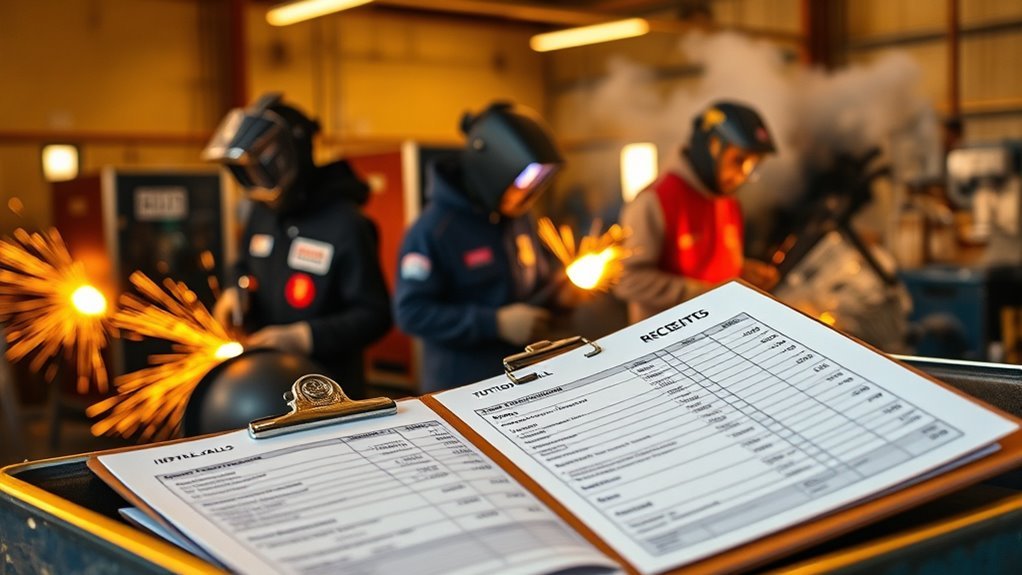If you’re thinking about getting a welding degree, you’ll want a clear picture of what it really costs. Tuition varies a lot by program type and length, and you’ll also face tool, gear, and living expenses that can add up. There are cheaper paths like apprenticeships and employer training, but each option affects your timeline and earning potential differently—so it pays to compare the numbers carefully.
Average Tuition and Fee Ranges for Welding Programs

While costs vary by program type and school, you can generally expect welding training to run from a few thousand dollars up to the low tens of thousands.
You’ll see certificate programs that take weeks to months and cost about $3,000–$10,000, diploma options around one year at $5,000–$15,000, and associate degrees over two years ranging $10,000–$25,000. Some specialized programs can exceed $20,000.
Community colleges often offer the most affordable pathway, with two-year courses averaging near $5,000 and including some general education credits.
Community colleges are often the most affordable route, offering two-year welding programs around $5,000 with general education credits included
Don’t forget extra expenses: equipment, materials, and safety gear may add $100–$2,500.
Use a straightforward tuition comparison to weigh program length, credentials, and total outlays. For smart financial planning, factor in living costs, potential lab fees, and certification exam costs so you know the full price up front and can compare true value across schools.
Types of Welding Schools and What They Cost

When choosing where to train, you’ll want to compare trade schools and community colleges side by side.
Trade schools usually focus on hands‑on welding and cost roughly $5,000–$20,000, while community college programs average about $5,000 for a two‑year degree and include general education courses.
Knowing these basic cost differences helps you pick the option that fits your budget and career goals.
Trade School Costs
Trade schools for welding usually cost between about $5,000 and $20,000, depending on program length and depth, so you can pick a short certificate, a yearlong diploma, or a two-year associate degree based on your budget and goals.
You’ll get hands-on training in multiple welding techniques, which is one of the main trade school advantages and helps boost your welding career prospects.
Certificate programs run weeks to months and commonly cost $3,000–$10,000. Diplomas take about a year and cost $5,000–$15,000.
Some trade schools offer two-year associate-level options up to $25,000 that include general classes. Expect extra expenses for safety gear and tools ($100–$2,500).
Choose a program that matches your timeline, budget, and target job market.
Community College Rates
If you want a more affordable, structured route than many private trade schools, community colleges are a solid choice for welding education.
You’ll find community college advantages in lower tuition — about $5,000 on average for a two-year welding course — and flexible certificate options that run a few weeks to several months costing roughly $3,000–$10,000.
Many campuses offer financial aid and evening or weekend classes, so you can balance work and study.
Expect to budget $100–$500 for materials and safety gear and another $100–$500 for books and supplies.
Programs often include general education classes, which may extend time to completion but add value.
Program Lengths: Certificate, Diploma, and Degree Costs

You’ll usually choose between short certificate courses, one-year diplomas, two-year associate degrees, or four-year bachelor’s programs, and each option has very different time and cost commitments.
For a quick entry, certificate program duration ranges from a few weeks to several months and typically costs $3,000–$10,000. Diploma programs offer a deeper foundation in about one year, with tuition around $5,000–$15,000. An associate degree takes roughly two years and runs $10,000–$25,000, while bachelor’s programs, which may add business or engineering coursework, usually take four years and can exceed $20,000.
When you weigh program comparison, consider your timeline, career goals, and budget. Short certificates get you into the shop fast; diplomas and associate degrees provide broader hands-on skills and credentials; a bachelor’s opens doors to supervisory, engineering-adjacent, or management roles.
Remember total cost varies by institution and you’ll need to factor additional expenses beyond tuition.
Equipment, Materials, and Supplies You’ll Need to Buy

Although tuition gets the headlines, don’t forget the out-of-pocket gear and supplies you’ll need to buy for welding school. Plan on $100–$500 for basic safety gear like helmets, gloves, and protective clothing; programs often list minimums you must meet before stepping into the shop.
Some schools require a tool kit; these can add costs for safety glasses, welding hoods, pliers, chisels, and other essentials.
If you want a personal welding machine, expect $500–$2,000 depending on type and brand — many students borrow shop machines, but owning one helps practice outside class.
Books and course supplies usually run another $100–$500, varying by curriculum.
Add these line items when you budget: safety gear, tool kits, machine (optional), and course materials. When you tally them, equipment and supplies can materially increase your total cost, so get program-specific lists and price items before you enroll.
Living Expenses and Cost of Attendance by Location

Because where you live can change costs dramatically, plan your welding-school budget around tuition plus realistic living expenses like rent, utilities, food, and transportation.
In Arizona, for example, off-campus room and board runs about $1,510.09 monthly including rent and utilities; utilities alone average roughly $408 per month. Add groceries at about $278.83 and personal costs near $1,025.72, and you see how the monthly living expenses stack up.
For students relocating, total tuition and fees for a welding program can reach around $19,000 — factor that into your annual cost breakdown alongside moving and setup costs.
If you live at home, expect lower costs but budget median travel expenses of about $313.41. Use location-specific figures to compare programs: low tuition in a high-rent area may cost more overall than higher tuition where housing is cheap.
Build a simple spreadsheet with tuition, housing, utilities, food, transport, and personal items to get a clear cost breakdown.
Financial Aid, Scholarships, Grants, and Loan Options

After you map out tuition and living costs, look at ways to lower what you actually pay: federal grants and low-interest student loans can cut your out-of-pocket total considerably, and many schools and organizations — like the American Welding Society — offer scholarships for qualifying students.
Use practical financial aid strategies: complete the FAFSA early to access federal grants and subsidized loans, compare interest rates and repayment terms, and document eligibility for the GI Bill® if you or a family member served.
Hunt for scholarship opportunities from schools, trade associations, and local foundations; apply to multiple awards to increase your chances. Track deadlines, tailor applications, and request letters of recommendation that highlight your skills.
Combine grants, scholarships, and loans to shrink a $5,000–$30,000 program cost to something manageable. Keep organized records of awards and loan terms so you can plan monthly budgets and loan repayment.
These steps make welding training financially feasible without relying on a single funding source.
Apprenticeships and Employer-Sponsored Training Alternatives

If you want to earn while you learn, apprenticeships and employer-sponsored training let you gain paid, on-the-job welding experience paired with classroom instruction, often starting at about $15–$20 per hour and lasting three to five years.
You’ll get hands-on skill development through welding apprenticeships that integrate practical shop work with formal classes, giving you a strong portfolio of real-world projects.
Employer-sponsored training can cover part or all tuition, often saving you $5,000 to $20,000 compared with self-funded programs. You’ll also benefit from employer benefits like health insurance, retirement plans, and tuition reimbursement for continuing education.
Because employers invest in your training, you’re more likely to secure full-time employment at program completion.
When evaluating options, compare wage progression, duration, classroom hours, and the specific employer benefits offered. Choose a program with clear pathways to journeyman status or steady placement in manufacturing, construction, or specialized welding sectors to maximize return on your time and effort.
Certification Costs and Industry Exam Fees

You’ll need to budget for certification exam fees, which can range from about $200 to over $1,000 depending on the credential and testing body.
Factor in extra costs for study materials, practice tests, and possible retake fees if you don’t pass the first time.
Also remember recertification and upgrades may carry periodic fees, though some employers will cover or reimburse those expenses.
Certification Exam Fees
Certification exam fees for welding vary widely, typically running from about $300 to $800 depending on the certification and testing organization, with specialized credentials like underwater welding sometimes topping $1,000.
You should budget for AWS and other exam costs—AWS’s Certified Welder runs about $300, though location fees can add up. Some schools roll exam fees into tuition; others bill them separately, so confirm with your program.
Factor exam prep strategies into your schedule and budget for practice time, materials, or mock tests to improve pass rates.
Remember the certification importance: employers often require specific credentials, so the upfront exam cost is an investment in employability.
Keep receipts and verify what’s covered before you register.
Recertification and Upgrades
After you’ve passed initial exams, plan for ongoing costs: recertification and upgrades can add regular fees and occasional larger expenses. You’ll face recertification requirements that vary—some every six months, others up to three years—with fees typically $100–$500 per exam. The AWS Certified Welder runs about $450. Specialized credentials (underwater, aerospace) often exceed $1,000. Look for upgrade options through bundled school packages that can lower costs.
| Item | Typical Cost |
|---|---|
| Standard recertification | $100–$500 |
| AWS Certified Welder | $450 |
| Specialized certifications | $1,000+ |
| Bundled exam packages | Varies (discounted) |
Budget for periodic retesting and occasional high-cost upgrades to keep your credentials current and marketable.
Calculating Return on Investment and Long-Term Earnings

When you weigh the upfront cost of a welding degree against expected earnings, focus on concrete numbers: median annual pay for welders was $47,540 in May 2022, while a two-year associate program typically runs $10,000–$25,000, and financial aid can lower that burden; factor in faster salary growth if you earn certifications or move into specialized or supervisory roles like underwater welding, and you’ll see how quickly the education can pay for itself.
Use welding salary trends and job market analysis to model ROI: compare program cost, living expenses during school, and expected starting pay in your target industry. Add projected raises from certifications and experience, and estimate time to recoup tuition.
Include opportunities in oil and gas, shipbuilding, and aerospace where pay is higher. Remember financial aid, scholarships, and apprenticeships reduce payback time. A conservative calculation often shows break-even within a few years, with long-term earnings rising substantially if you specialize or move into supervisory roles.
Frequently Asked Questions
Can I Transfer Welding Credits Between Schools or Programs?
Yes — you can often transfer welding credits, but policies vary. Check each school’s credit transfer policies and confirm program accreditation matches; contact admissions and your prospective program director to verify accepted courses, lab hours, and articulation agreements.
Are Online Welding Courses Accepted by Employers?
Yes — you’ll find employers accept online welding benefits when courses come with hands-on labs, industry certifications, and reputable schools; employer perceptions favor demonstrated skills and credentials, so prioritize practical training, photos, weld tests, and references.
What Safety Gear Is Required Beyond Program-Provided Items?
You’ll need additional safety gear beyond program-provided items: a certified welding helmet, flame-resistant jacket, leather gloves, steel-toe boots, ear protection, respirator, and safety glasses as part of your personal protective equipment for safe welding practices.
Do Welding Programs Include Job Placement Assistance?
Yes — many welding programs include job placement support as a core program benefit; they’ll connect you with employers, offer resume help, mock interviews, and apprenticeship leads so you can shift quickly into paid welding work.
How Often Do Welding Skills Require Recertification?
You’ll typically face recertification frequency of every 6–36 months depending on employer, code (AWS/ASME), and weld type; you’ll keep skill relevance by retesting, refresher courses, and on-the-job practice to stay current and qualified.
Conclusion
Getting a welding credential can be a smart move if you weigh costs and benefits. Factor tuition (certificate $3–10K, diploma $5–15K, associate $10–25K), gear ($100–2,500), living expenses, and certification fees. Use financial aid, scholarships, apprenticeships, or employer training to cut out-of-pocket costs. Compare local demand and expected wages to calculate ROI—don’t throw good money after bad; aim for the path that pays off fastest while matching your career goals.


